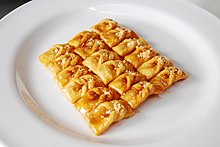food.wikisort.org - Dish
Maejap-gwa (매잡과; 梅雜菓), also called maejak-gwa (매작과; 梅雀菓) or tarae-gwa (타래과), is a ribbon-shaped hangwa (traditional Korean confection).[2][3][4]
 | |
| Alternative names | Maejak-gwa, tarae-gwa |
|---|---|
| Type | Yumil-gwa |
| Place of origin | Korea |
| Associated national cuisine | Korean cuisine |
Food energy (per 4 serving) | 150 kcal (628 kJ)[1] |
| Korean name | |
| Hangul | 매잡과 |
|---|---|
| Hanja | 梅雜菓 |
| Revised Romanization | maejap-gwa |
| McCune–Reischauer | maejap-kwa |
| IPA | [mɛ.dʑap̚.k͈wa] |
| Hangul | 매작과 |
| Hanja | 梅雀菓 |
| Revised Romanization | maejak-gwa |
| McCune–Reischauer | maejak-kwa |
| IPA | [mɛ.dʑak̚.k͈wa] |
| Hangul | 타래과 |
| Hanja | --菓 |
| Revised Romanization | tarae-gwa |
| McCune–Reischauer | t'arae-kwa |
| IPA | [tʰa.ɾɛ.ɡwa] |
Preparation
Wheat flour is kneaded with ginger juice and water, then rolled into a flat sheet.[5] The sheet is then cut into small rectangles with three slits in the middle, and the end of each piece is put through the middle slit.[5] The ribbons are then deep-fried, coated in honey or jocheong followed by chopped pine nuts.[5]
Gallery
- Walnut jeonggwa (left) and maejap-gwa (right), from an Asiana airlines in-flight meal
See also
- Angel wings
- Yumil-gwa
References
- "Maejakgwa". Korean Food Foundation. Retrieved 22 April 2017.
- "maejap-gwa" 매잡과. Standard Korean Language Dictionary (in Korean). National Institute of Korean Language. Retrieved 22 April 2017.
- "maejak-gwa" 매작과. Standard Korean Language Dictionary (in Korean). National Institute of Korean Language. Retrieved 22 April 2017.
- "tarae-gwa" 타래과. Standard Korean Language Dictionary (in Korean). National Institute of Korean Language. Retrieved 22 April 2017.
- Kwon, Yong-Seok; Kim, Young; Kim, Yang-Suk; Choe, Jeong-Sook; Lee, Jin-Young (2012). "An Exploratory Study on Kwa-Jung-ryu of Head Families". Journal of the Korean Society of Food Culture (in Korean). 27 (6): 588–597. doi:10.7318/kjfc/2012.27.6.588.
Текст в блоке "Читать" взят с сайта "Википедия" и доступен по лицензии Creative Commons Attribution-ShareAlike; в отдельных случаях могут действовать дополнительные условия.
Другой контент может иметь иную лицензию. Перед использованием материалов сайта WikiSort.org внимательно изучите правила лицензирования конкретных элементов наполнения сайта.
Другой контент может иметь иную лицензию. Перед использованием материалов сайта WikiSort.org внимательно изучите правила лицензирования конкретных элементов наполнения сайта.
2019-2025
WikiSort.org - проект по пересортировке и дополнению контента Википедии
WikiSort.org - проект по пересортировке и дополнению контента Википедии

